EnjoyingSoft之Mule ESB开发教程第六篇:Data Transform - 数据转换
本篇主要介绍在Mule ESB中使用数据转换。数据转换是ESB最核心的功能,它消除了异构应用之间的技术差异,让不同的应用服务协调运作,实现了不同服务之间的通讯。数据转换或者说消息转换,包括了数据结构,数据类型,数据内容的转换等。
作为开源ESB产品中很成熟的平台,Mule ESB内置很多的消息转换组件,比如Object to JSON,Object to XML,XML to JSON等,同时也支持使用自定义的Transformer来扩充自定义转换逻辑。
另外Mule ESB企业版更拥有图形化的消息转换组件DataWeave,可以很灵活的进行数据的转换,包括一对一,一对多,多对一的映射。我们在社区版上也研发了相应的扩展组件InfoMapper,做到类似DataWeave的强大功能。
Mule ESB起源于一个社区项目,经过十多年的发展,Mule ESB拥有众多的企业客户案例,2017年成功在纽交所上市。我们作为MuleSoft的重要合作伙伴,参与其中,使用Mule ESB企业版实施开发,或者Mule ESB社区版实施开发,帮助国内众多的行业领先客户成功上线Mule ESB集成项目。
Mule ESB的源代码托管在GitHub上,英文文档也非常丰富,Mule ESB的中文教程却非常少,我们使用8篇Mule ESB的开发教程来帮助大家迅速上手Mule ESB开发。
- EnjoyingSoft之Mule ESB开发教程第一篇:初识Mule ESB
- EnjoyingSoft之Mule ESB开发教程第二篇:Mule ESB基本概念
- EnjoyingSoft之Mule ESB开发教程第三篇:Mule message structure - Mule message结构
- EnjoyingSoft之Mule ESB开发教程第四篇:Mule Expression Language - MEL表达式
- EnjoyingSoft之Mule ESB开发教程第五篇:控制消息的流向-数据路由
- EnjoyingSoft之Mule ESB开发教程第六篇:Data Transform - 数据转换
- EnjoyingSoft之Mule ESB开发教程第七篇:SOAP Web Service的消费和创建
- EnjoyingSoft之Mule ESB开发教程第八篇:使用API构建Rest Service
1. 数据转换概念
数据转换是ESB平台的核心模块,是解决异构系统通讯的必备组件。举个例子,订单系统暴露了一个Web Service,而我们的网上商城生成的订单是Json或者Flat file格式,将JSON数据或者Flat file文本格式转换成Web Service的XML格式,这个需求就可以通过ESB来实现。我们在第三篇讲解了Mule Message的结构,回忆一下Mule Message的结构。
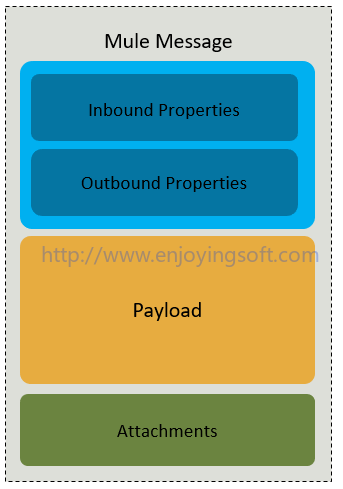
我们通常说的数据转换就是对Mule Message中Payload做操作,改变数据类型或者数据结构,数据内容等。在做数据转换之前,我们需要确定数据的源类型和目标类型,然后选择合适的数据转换组件。

2. 数据智能感知 - DataSense
DataSense是Mule最强大的功能之一,Anypoint Studio会主动获取元数据类型和结构等信息,以帮助开发者在应用程序中准确的映射或者使用数据。
DataSense配合企业版的DataWeave可视化数据转化组件,或者我们自研的社区版可视化数据转化组件InfoMapper,能够很大的加速应用集成的开发,方便开发者完成数据转换和映射。本文后半段会介绍DataWeave和InfoMapper的强大之处。
DataSense举例说明,如果您的应用程序连接到一个天气预报的Web Service,那么DataSense会捕获Web Service使用的数据类型和结构的信息,这些信息对开发者非常有用,它会展示这个Web Service期望的的入参是什么,出参是什么。
天气预报WebService中规定的入参和出参如下图:
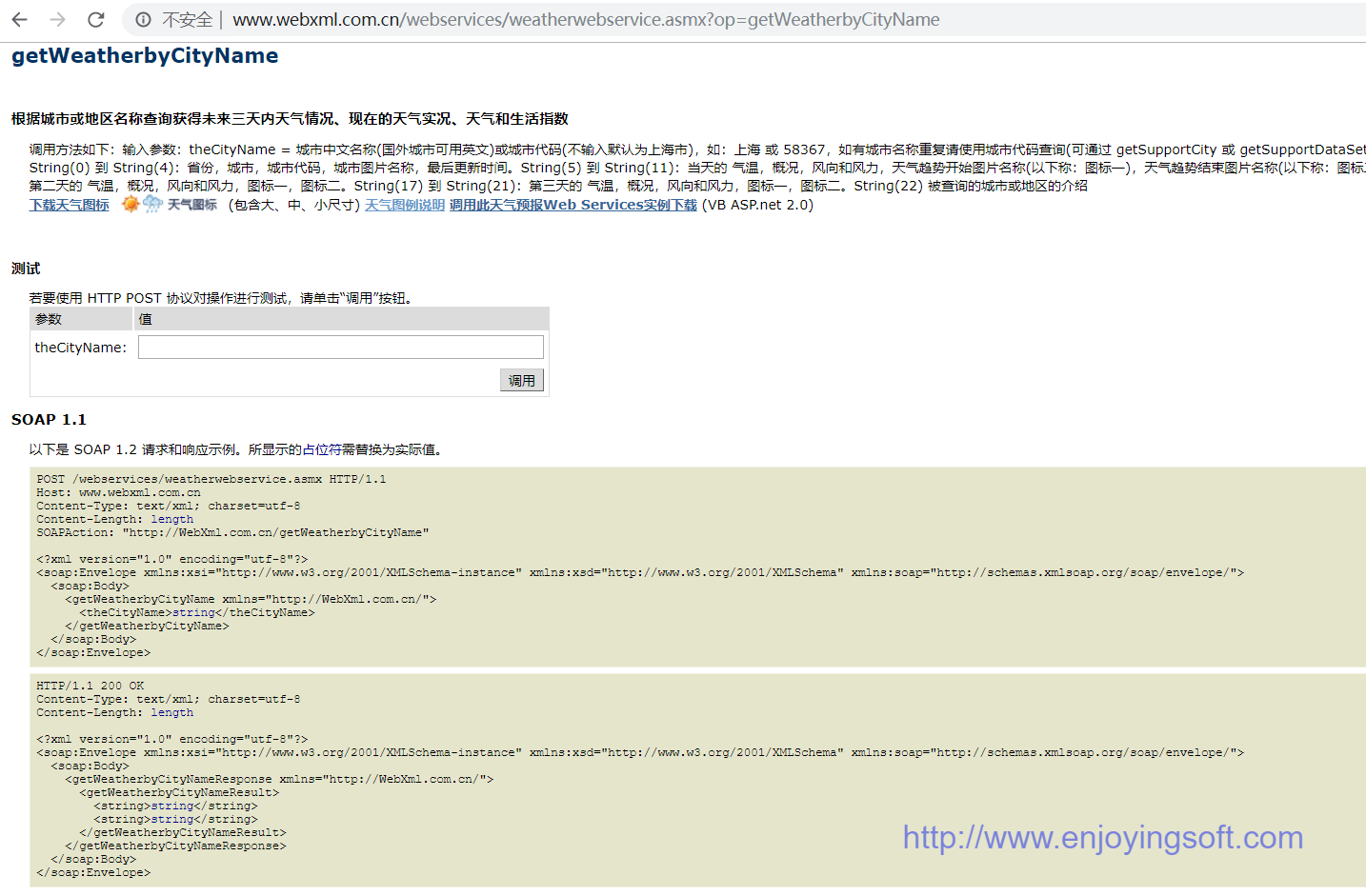
Anypoint Studio中的Web Service Consumer组件,会清楚的显示Expected Data,也就是期望的入参数据格式。如下图Input页签,可以看到需要输入theCityName的XML数据。
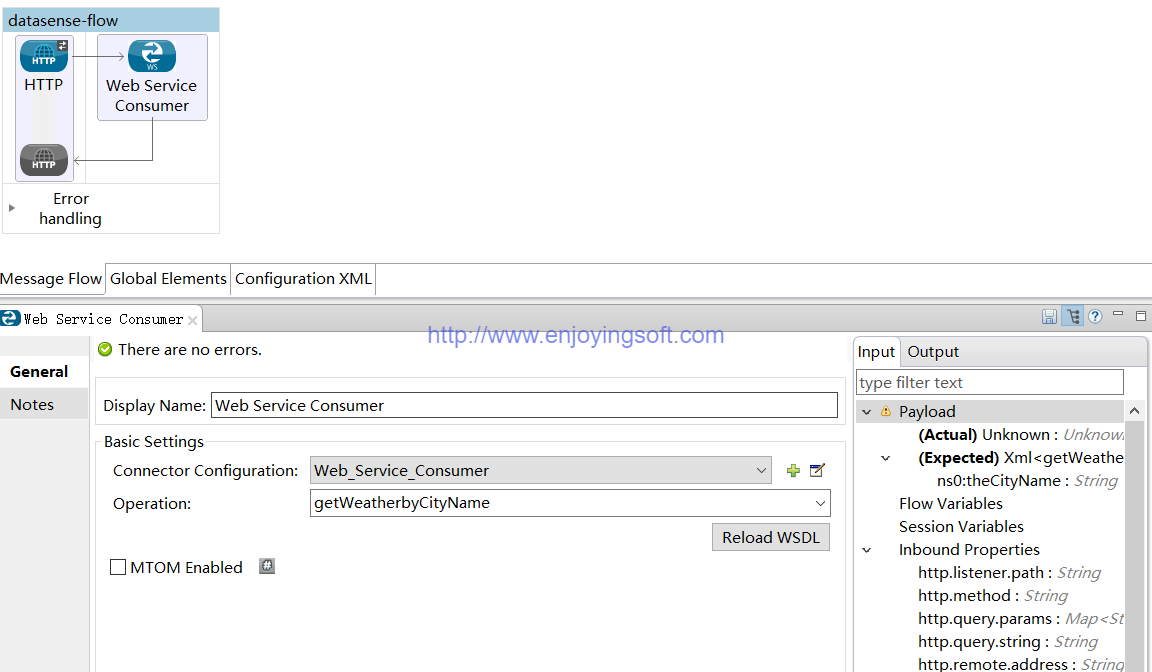
同时Web Service Consumer组件也会展示这个WebService的输出参数是什么。如下图Output页签。
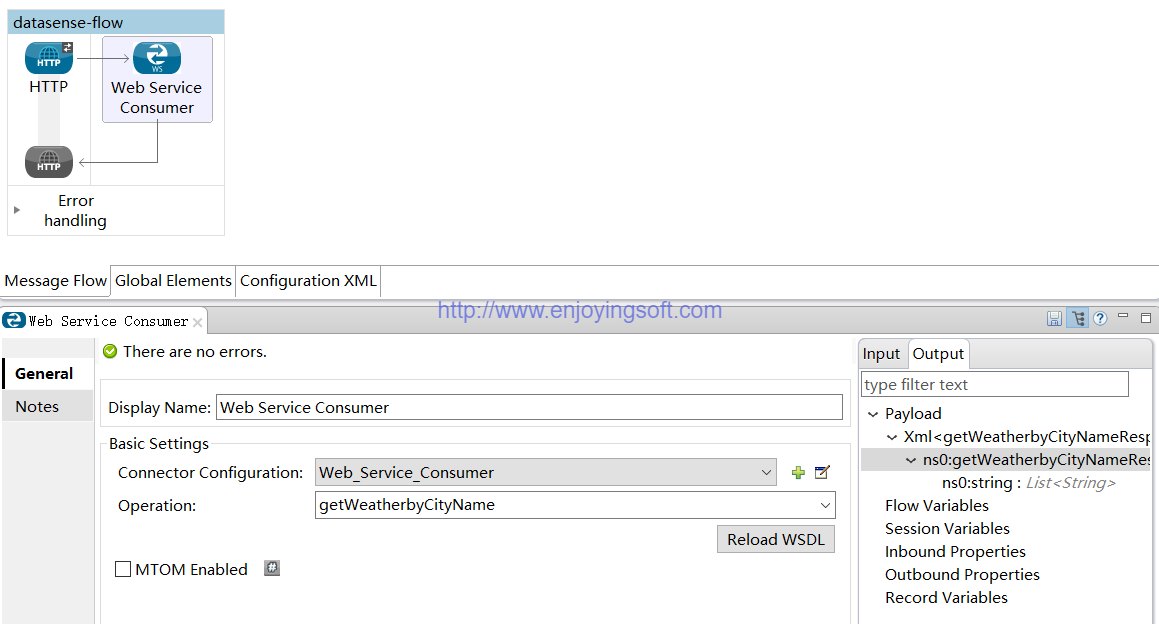
3. 简单数据转换组件
Mule ESB内置了很多常用的简单的数据转换组件,从组件名称就可以看到组件的适用范围,源数据类型和目标数据类型。另外Mule ESB也支持自定义Transformer,通过Java或者其他脚本语言实现复杂的数据转换逻辑。
3.1 Object to JSON
Object to JSON组件能够将Java对象转换成JSON格式,方便其他语言比如C#,Python解析和使用。常见的使用场景就是将Map对象转换成JSON格式。
Mule UI Config:

Mule XML Config:
<?xml version="1.0" encoding="UTF-8"?>
<mule xmlns:json="http://www.mulesoft.org/schema/mule/json"
xmlns:http="http://www.mulesoft.org/schema/mule/http" xmlns="http://www.mulesoft.org/schema/mule/core" xmlns:doc="http://www.mulesoft.org/schema/mule/documentation"
xmlns:spring="http://www.springframework.org/schema/beans"
xmlns:xsi="http://www.w3.org/2001/XMLSchema-instance"
xsi:schemaLocation="
http://www.mulesoft.org/schema/mule/json http://www.mulesoft.org/schema/mule/json/current/mule-json.xsd http://www.springframework.org/schema/beans http://www.springframework.org/schema/beans/spring-beans-current.xsd
http://www.mulesoft.org/schema/mule/core http://www.mulesoft.org/schema/mule/core/current/mule.xsd
http://www.mulesoft.org/schema/mule/http http://www.mulesoft.org/schema/mule/http/current/mule-http.xsd">
<http:listener-config name="HTTP_Listener_Configuration" host="0.0.0.0" port="8081" doc:name="HTTP Listener Configuration"/>
<flow name="object-to-json-flow">
<http:listener config-ref="HTTP_Listener_Configuration" path="/" doc:name="HTTP"/>
<set-payload value="#[["orderNo":"OST0001","orderAmount":1000]]" doc:name="Set Map Payload"/>
<json:object-to-json-transformer doc:name="Object to JSON"/>
</flow>
</mule>
使用Postman访问,就可以得到一个标准的JSON数据。
{
"orderAmount": 1000,
"orderNo": "OST0001"
}
3.2 JSON to XML
JSON转换成XML是很常用的转换操作。JSON和XML都是有层级关系的数据展示结构,JSON和XML具体的区别和使用场景请参考其他文章。这里需要强调是XML有一个唯一的根节点元素,而JSON根节点元素可能是一个对象,还可能是一个数组。使用Mule完成JSON to XML也很简单。
Mule UI Config:
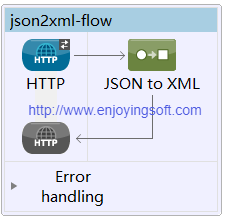
Mule XML Config:
<?xml version="1.0" encoding="UTF-8"?>
<mule xmlns:json="http://www.mulesoft.org/schema/mule/json" xmlns:http="http://www.mulesoft.org/schema/mule/http" xmlns="http://www.mulesoft.org/schema/mule/core" xmlns:doc="http://www.mulesoft.org/schema/mule/documentation"
xmlns:spring="http://www.springframework.org/schema/beans"
xmlns:xsi="http://www.w3.org/2001/XMLSchema-instance"
xsi:schemaLocation="http://www.springframework.org/schema/beans http://www.springframework.org/schema/beans/spring-beans-current.xsd
http://www.mulesoft.org/schema/mule/core http://www.mulesoft.org/schema/mule/core/current/mule.xsd
http://www.mulesoft.org/schema/mule/http http://www.mulesoft.org/schema/mule/http/current/mule-http.xsd
http://www.mulesoft.org/schema/mule/json http://www.mulesoft.org/schema/mule/json/current/mule-json.xsd">
<http:listener-config name="HTTP_Listener_Configuration" host="0.0.0.0" port="8081" doc:name="HTTP Listener Configuration"/>
<flow name="json2xml-flow">
<http:listener config-ref="HTTP_Listener_Configuration" path="/" doc:name="HTTP"/>
<json:json-to-xml-transformer doc:name="JSON to XML"/>
</flow>
</mule>
使用Postman提交Json,Json数据如下:
{
"customer": {
"cellPhone": "13912340002",
"customerNo": "C0002",
"customerName": "Alibaba"
}
}
得到转换之后的结果如下:
<?xml version='1.0'?>
<customer>
<cellPhone>13912340002</cellPhone>
<customerNo>C0002</customerNo>
<customerName>Alibaba</customerName>
</customer>
这里还是要再次强调一下,这个组件要求Json数据必须只有一个根节点。如果Json数据里有多个根节点,则数据会丢失。举例如下:
有多个根节点元素的Json数据:
{
"cellPhone": "13912340002",
"customerNo": "C0002",
"customerName": "Alibaba"
}
转换后的XML结果如下,可以看到只有第一个根元素被转换成了XML。
<?xml version='1.0'?>
<cellPhone>13912340002</cellPhone>
3.3 JSON to Object
这个组件会将JSON数据转成成一个Mule内置的Json对象,org.mule.module.json.JsonData。
Mule UI Config:

Mule XML Config:
<?xml version="1.0" encoding="UTF-8"?>
<mule xmlns:json="http://www.mulesoft.org/schema/mule/json" xmlns:http="http://www.mulesoft.org/schema/mule/http" xmlns="http://www.mulesoft.org/schema/mule/core" xmlns:doc="http://www.mulesoft.org/schema/mule/documentation"
xmlns:spring="http://www.springframework.org/schema/beans"
xmlns:xsi="http://www.w3.org/2001/XMLSchema-instance"
xsi:schemaLocation="http://www.springframework.org/schema/beans http://www.springframework.org/schema/beans/spring-beans-current.xsd
http://www.mulesoft.org/schema/mule/core http://www.mulesoft.org/schema/mule/core/current/mule.xsd
http://www.mulesoft.org/schema/mule/http http://www.mulesoft.org/schema/mule/http/current/mule-http.xsd
http://www.mulesoft.org/schema/mule/json http://www.mulesoft.org/schema/mule/json/current/mule-json.xsd">
<http:listener-config name="HTTP_Listener_Configuration" host="0.0.0.0" port="8081" doc:name="HTTP Listener Configuration"/>
<flow name="json2object-flow">
<http:listener config-ref="HTTP_Listener_Configuration" path="/" doc:name="HTTP"/>
<json:json-to-object-transformer doc:name="JSON to Object"/>
<logger message="#[message]" level="INFO" doc:name="Logger"/>
</flow>
</mule>
通过打印的日志可以看到,转化后的payload是org.mule.module.json.JsonData。
org.mule.DefaultMuleMessage
{
id=4b3b1290-b293-11e9-9351-005056c00001
payload=org.mule.module.json.JsonData
correlationId=<not set>
correlationGroup=-1
correlationSeq=-1
encoding=UTF-8
exceptionPayload=<not set>
}
3.4 XML to JSON
正如2.2章节所说,XML和Json的根节点元素存在差异。而XML的根节点元素是唯一的,所以XML to JSON比较简单。
Mule UI Config:

Mule XML Config:
<?xml version="1.0" encoding="UTF-8"?>
<mule xmlns:json="http://www.mulesoft.org/schema/mule/json" xmlns:http="http://www.mulesoft.org/schema/mule/http" xmlns="http://www.mulesoft.org/schema/mule/core" xmlns:doc="http://www.mulesoft.org/schema/mule/documentation"
xmlns:spring="http://www.springframework.org/schema/beans"
xmlns:xsi="http://www.w3.org/2001/XMLSchema-instance"
xsi:schemaLocation="http://www.springframework.org/schema/beans http://www.springframework.org/schema/beans/spring-beans-current.xsd
http://www.mulesoft.org/schema/mule/core http://www.mulesoft.org/schema/mule/core/current/mule.xsd
http://www.mulesoft.org/schema/mule/http http://www.mulesoft.org/schema/mule/http/current/mule-http.xsd
http://www.mulesoft.org/schema/mule/json http://www.mulesoft.org/schema/mule/json/current/mule-json.xsd">
<http:listener-config name="HTTP_Listener_Configuration" host="0.0.0.0" port="8081" doc:name="HTTP Listener Configuration"/>
<flow name="xml2json-flow">
<http:listener config-ref="HTTP_Listener_Configuration" path="/" doc:name="HTTP"/>
<json:xml-to-json-transformer doc:name="XML to JSON"/>
</flow>
</mule>
使用Postman提交Xml,Xml数据如下:
<?xml version='1.0'?>
<customer>
<cellPhone>13912340002</cellPhone>
<customerNo>C0002</customerNo>
<customerName>Alibaba</customerName>
</customer>
转化后的JSON数据如下,可以看到这里的Json是正确的。
{
"customer": {
"cellPhone": "13912340002",
"customerNo": "C0002",
"customerName": "Alibaba"
}
}
4. 企业版的DataWeave Transformer(可视化高级数据转换器)
DataWeave是Mule企业版提供的可视化的数据换器,使用这个组件可以通过拖拽的操作完成数据的映射。从下图可以看到,DataWeave配合DataSense,通过拖拽连线的方式,可以将Http的请求数据转换成Web Service Consumer期待的Xml数据,非常好用方便。

5. 社区版的InfoMapper(自研的可视化数据转换器)
上文提到的DataWeave是Mule企业版才提供的功能,社区版并不提供该组件。我们也可以通过扩展组件的方式达到类似的功能,我们自研的可视化转换组件InfoMapper,其功能和DataWeave相当。
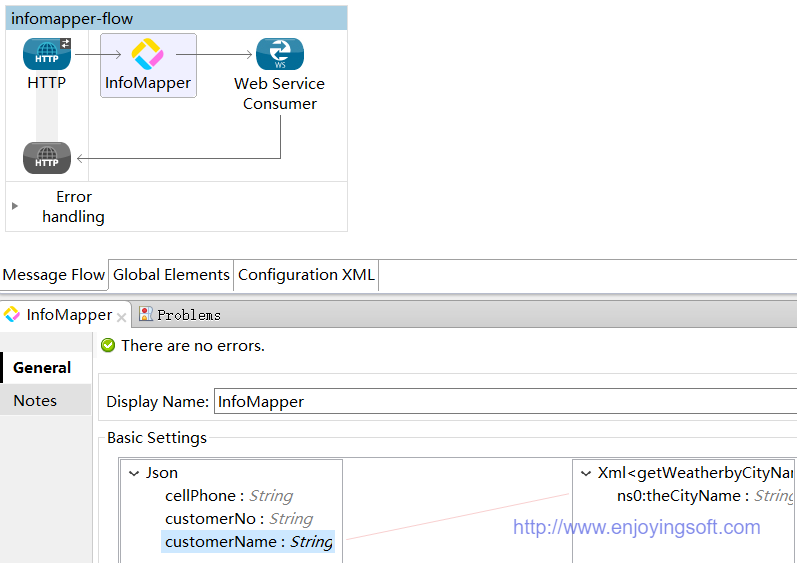
数据转换是ESB很常用的功能和使用场景,使用Anypoint Studio中提供的简单数据转换组件,或者企业版的DataWeave,社区版我们自研的InfoMapper这些高级转换组件,配合强大的DataSense,数据转换是非常轻松的事情。
本文同步发文于EnjoyingSoft Blogs ,CSDN,简书
访问EnjoyingSoft 网站,获取更多Mule ESB 社区版 实施帮助。
欢迎转载,但必须保留原文和此段声明,且在文章页面明显位置给出原文链接,否则保留追究法律责任的权利。
EnjoyingSoft之Mule ESB开发教程第六篇:Data Transform - 数据转换的更多相关文章
- EnjoyingSoft之Mule ESB开发教程第三篇:Mule message structure - Mule message结构
目录 1. 探索Mule Message结构 2. Mule Message的Payload 3. Mule Message的Property 4. Mule Message的Attachment 5 ...
- EnjoyingSoft之Mule ESB开发教程第四篇:Mule Expression Language - MEL表达式
目录 1. MEL的优势 2. MEL的使用场景 3. MEL的示例 4. MEL的上下文对象 5. MEL的Variable 6. MEL访问属性 7. MEL操作符 本篇主要介绍Mule表达式语言 ...
- EnjoyingSoft之Mule ESB开发教程系列第五篇:控制消息的流向-数据路由
目录 1. 使用场景 2. 基于消息头的路由 2.1 使用JSON提交订单的消息 2.2 使用XML提交订单的消息 2.3 使用Choice组件判断订单格式 3. 基于消息内容的路由 4. 其他控制流 ...
- EnjoyingSoft之Mule ESB开发教程第一篇:初识Mule ESB
目录 1. Mule ESB基本介绍 2. Mule ESB社区版和企业版 3. Mule ESB常用场景 4. Mule ESB软件安装 客户端安装 服务端安装 5. 第一个Mule ESB应用- ...
- EnjoyingSoft之Mule ESB开发教程第二篇:Mule ESB基本概念
目录 1. 使用Anypoint Studio开发 2. Mule ESB Application Structure - Mule ESB应用程序结构 3. Mule ESB Application ...
- Senparc.Weixin.MP SDK 微信公众平台开发教程(六):了解MessageHandler
上一篇<Senparc.Weixin.MP SDK 微信公众平台开发教程(五):使用Senparc.Weixin.MP SDK>我们讲述了如何使用Senparc.Weixin.MP SDK ...
- iOS 11开发教程(六)iOS11Main.storyboard文件编辑界面
iOS 11开发教程(六)iOS11Main.storyboard文件编辑界面 在1.2.2小节中提到过编辑界面(Interface builder),编辑界面是用来设计用户界面的,单击打开Main. ...
- [051] 微信公众平台开发教程第22篇-怎样保证access_token长期有效
为了使第三方开发人员能够为用户提供很多其它更有价值的个性化服务,微信公众平台开放了很多接口,包含自己定义菜单接口.客服接口.获取用户信息接口.用户分组接口.群发接口等,开发人员在调用这些接口时.都须要 ...
- spring cloud系列教程第六篇-Eureka集群版
spring cloud系列教程第六篇-Eureka集群版 本文主要内容: 本文来源:本文由凯哥Java(kaigejava)发布在博客园博客的.转载请注明 1:Eureka执行步骤理解 2:集群原理 ...
随机推荐
- QT 资料收集 (不定期添加)
Qt之界面实现技巧 http://blog.sina.com.cn/s/blog_a6fb6cc90101dech.html
- 浅说——数位DP
老子听懂了!!!!! 好感动!!! 不说多了:Keywords: 数位DP,二进制,异或. “在信息学竞赛中,有一类与数位有关的区间统计问题.这类问题往往具有比较浓厚的数学味道,无法暴力求解,需要在数 ...
- SCUT 130:对抗女巫的魔法碎片(贪心)
https://scut.online/p/130 130. 对抗女巫的魔法碎片 题目描述 光明世界的一个国家发生动荡,女巫利用了邪恶的力量将国家的村庄都施下了咒语,好在国家还有英勇的士兵,他们正义的 ...
- Android 装逼技术之暗码启动应用
什么是暗码? 在拨号盘中输入*#*#<code>#*#*后,APP 可以监控到这些输入,然后做相应的动作,比如启动应用,是不是有点骚. 下面看下这个骚操作是如何实现的. 效果预览 源码 D ...
- .NetCore应用多个target framework
<Project Sdk="Microsoft.NET.Sdk.Web"> <PropertyGroup> <TargetFrameworks> ...
- ~~番外:说说Python 面向对象编程~~
进击のpython Python 是支持面向对象的 很多情况下使用面向对象编程会使得代码更加容易扩展,并且可维护性更高 但是如果你写的多了或者某一对象非常复杂了,其中的一些写法会相当相当繁琐 而且我们 ...
- [Spring+SpringMVC+Mybatis]框架学习笔记(六):事务
第7讲 事务 7.1 事务的概念 事务是一系列作为一个逻辑单元来执行的操作集合. 它是数据库维护数据一致性的单位,它讲数据库从一个一致状态,转变为新的另外一个一致状态.说的简单一点就是:如果一组处理步 ...
- Java用Xom生成XML文档
这个总结源于Java编程思想第四版18.13节的案例: 完整代码地址: Java编程思想:XML 相关Api地址: Attribute Element Document Serializer 由于案例 ...
- SSAS Tabular关系设计--时间最小粒度维度
这两天设计的T2模型,涉及日期维度表中粒度的选择,因为一般实际销售达成ACT表是按天为标准记录的,而销售目标表TGT一般是按月记录,特此总结一下建模技巧. 数据仓库: 时间维度表,最小粒度为DATE. ...
- QQ Music 音乐插件DFX unable to open skin configration 的解决方法
设置 C:\Program Files (x86)\Tencent\QQMusic\Plugins\Dfx\dfx_skin.txt 它的权限 允许程序读取执行
